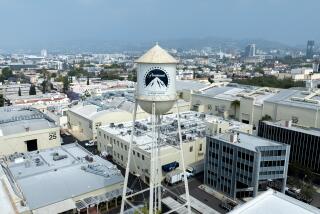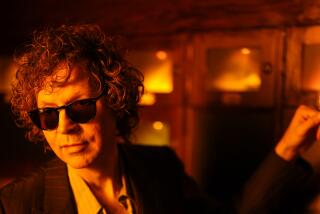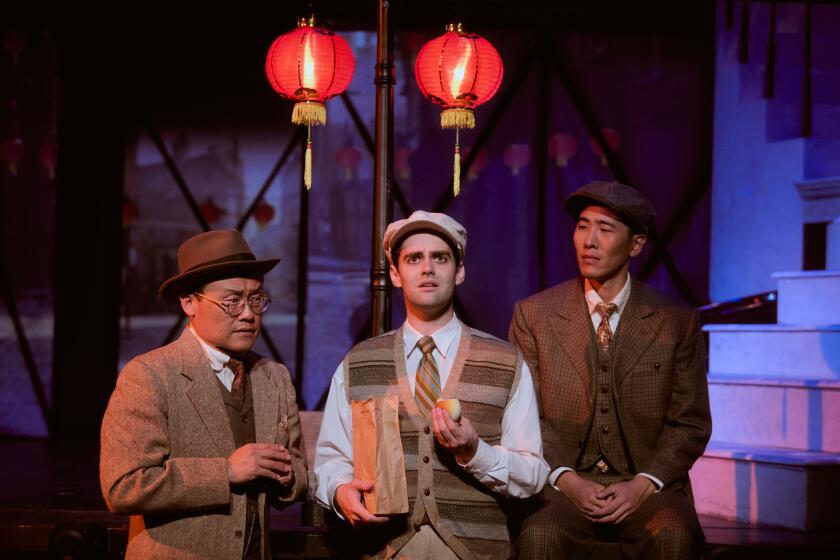The Artist at the Helm : Can Festival Director Peter Sellars Pull It Off on Vision Alone?
Triumphant music poured out of the piano at the Dorothy Chandler Pavilion Rehearsal Room 3 as dozens of casually dressed singers cheerfully nodded to each other and animatedly moved their lips in “pretend” conversation. A man with a porcupine haircut watched anxiously nearby, his arms crossed across his chest, his hands clasped underneath his chin.
Moments later, the man addressed the group with an enthusiastic good humor that was not far removed from a scolding aerobics instructor’s: “AND NO OPERA TALK! You know what opera talk is,” he said, exaggeratedly moving his mouth in silence. The adult group erupted into laughter.
“Have real conversations, it looks better,” Peter Sellars continued as the singers and actors starring in the production of his opera, “Nixon in China,” regarded him with visible adoration. “It doesn’t make you look like a low-IQ retard.” Giggles and chuckles again.
It was almost 10 p.m., and Sellars, the controversial and acclaimed stage director who is masterminding the upcoming Los Angeles Festival, was weaving his infectious spell again. The rigors of an exhausting day promoting and organizing the festival seemed only to heighten his energy level.
Over several hours, he had appeared on KABC-AM (790), taught a class at UCLA on “Nixon in China” (one of the highlights of the festival), taped introductions for festival films at KCET Channel 28, screened another film on the festival list, talked to a reporter at an entertainment trade magazine, and sat in on several meetings at the hyperactive festival office in downtown Los Angeles.
Throughout the grueling day, Sellars seemed to retain the charm, enthusiasm and high-spirited inventiveness that has endeared him to numerous local officials and members of the international arts community. Mayor Bradley frequently gushes with praise for Sellars, saying the 32-year-old director--often referred to within the arts community as a wunderkind or enfant terrible-- would be responsible for bringing to Los Angeles the “largest showcase of international performing and creative artistry . . . ever.”
But as the festival nears its opening ceremony Saturday at San Pedro’s Point Fermin/Angel’s Gate Park, happy anticipation has been clouded by reports of last-minute scheduling conflicts, financial difficulties, planning problems and charges of mismanagement against Sellars and festival staff. Complaints have ranged from the difficult-to-read and much-delayed festival program to whether there will be enough parking for those attending opening day.
Festival officials this week were still raising funds, trying to overcome a $30,000 deficit resulting from the rejection of a grant from the National Endowment for the Arts. An earlier $200,000 shortfall in the $5-million festival budget resulted in the scaling back of some programs.
One Los Angeles city councilman said festival organizers were not trying hard enough to attract a mainstream audience, and were concentrating too much on avant-garde events that were most likely to attract a Westside, “slightly counterculture,” yuppie audience.
Other observers said Sellars’ decision, soon after his appointment in 1987, to postpone the festival for a year and his recent work on other projects outside the country harmed fund-raising efforts and upset the festival’s momentum, resulting in last-minute organizational chaos as frantic officials try to put it all together in the final few days.
A little more than a month before opening day, Sellars was abruptly called away to Vienna for 10 days to edit his five-hour video of Handel’s opera “Julius Caesar.”
In general, Sellars’ detractors have labeled him a creative genius, but a failure administratively.
During a press conference in Bradley’s office last June, Sellars spouted incorrect numbers for artists participating in the festival and expected crowd sizes. Judith Luther, the festival’s executive director, quietly provided correct figures to a reporter sitting next to her.
Sellars has also contradicted himself at times. When he first laid out plans for the festival, he said his aim was to attract an audience that didn’t normally attend arts festivals, and that he wanted to reach out to ethnic groups. The festival, he said, was more than just an attraction for the Westside crowd.
But he changed his tune this summer when local commercial TV managers charged festival officials with doing a poor job advertising the festival. They said organizers had made no effort to use their stations in promotion.
“The festival is going to function by word-of-mouth this time, and that’s just fine,” he countered. “I’m not running a sweepstakes here, this is not marketing for Vons. I want people who really care about art and that’s enough. That’s plenty.”
Los Angeles City Councilman Michael Woo said in a recent interview, “I am very aware that I talk to people who are totally unaware of this festival.” He said organizers needed to work harder to appeal to an audience “beyond the slightly countercultural yuppie crowd. I would like to see more of an attempt to reach a mainstream audience.”
Festival officials say that their gala has been the subject of more criticism than the 1984 Olympic Arts Festival or its 1987 successor.
“It’s the whole nature of this festival that has put us under all this scrutiny,” said Maureen A. Kindel, chairwoman of the festival’s board of directors, who also oversaw the previous two festivals.
“This time, we are ‘out there,’ ” Kindel said. “There are a lot of ethnic communities involved. In the past, there were fewer contracts and fewer participants. But we opened the door this time and let a lot in. That puts us under greater scrutiny. The press has been mixed, but in line of what I would expect of a festival on the cutting edge.”
More than 1,400 artists from 21 countries are expected to participate in 230 events and 70 venues throughout Southern California. Unlike the previous two festivals, this year’s event focuses on art and culture from the Pacific Rim: Asia, Latin America and Oceania.
Although several programs have already sold out, and the event has the financial and political backing of Bradley and most of the city administration, doubts remain in the final countdown: Can Sellars really pull off so massive an undertaking?
If Sellars is bothered by the controversies, he doesn’t let on. During an interview in a Los Feliz coffee shop earlier this week, he exuded confidence that everything would come together. He is used to criticism, and, in a way, welcomes it.
“Anyone who thinks this festival is about me and what I want . . . well, let me just say there are easier and better ways for me to do that,” Sellars said inhaling heavily as he laughed. “If I just wanted to put myself forward, I can think of many easier ways to do it.”
He admitted that the festival has not been the most smoothly run or organized. “In terms of putting this together logistically, we’re right against the wall. We’re walking a tightrope. But this isn’t a logistics festival. It’s an arts festival.”
He said late funding, a scramble for adequate staff “and just the sheer difficulty of coping with the geography of this city” plagued the event from the start. “Much of this is being done at the last minute. I would have loved to have more money for advertising, for example. But we made a decision to pay the artists rather than advertise.”
The main problem with planning revolved around timing and money. He didn’t postpone plans for a 1989 festival soon after his appointment, he said. He refused to put on a festival earlier than 1990.
“It was never a condition of my contract” with the L.A. Festival Board of Directors, the independent panel that runs the festival, Sellars said. “I would have never done a 1989 festival. There just was not any time or preparation for that.”
He said it took him a year to get to know all the “right” artists and officials that he wanted to involve in this year’s event.
Cash flow was also a problem. Festival officials said they did not have much money to work with after the bills for the 1987 festival were paid. The total assets were $182,000. The actual cash was $19,428. A $250,000 grant from the Community Redevelopment Agency was one of the main contributions keeping the festival alive. There was not enough money to bring on a staff until last summer.
Sellars said he has even declined to accept his own $100,000 annual salary as director “because the festival needs so much money.”
According to the festival’s Judith Luther, “The thing that really hurt us was starting so late. It’s not a result of poor planning or management. The resources and money we needed were not in place early enough. Consequently, everyone is playing catch-up.”
Sellars admitted his shortcomings as a festival director, but said his staff has handled the necessary organization and details. He said he was hired for his artistic vision, not for his administrative skills.
“I don’t pretend to be an administrator. I’m a stage director. I do that pretty well,” he said, again inhaling as he chuckled. “This is on-the-job training. There’s been nothing like this before, so of course it’s an experiment. We’re genuinely feeling our way. A lot of things are being done on the run.
“It’s like a bumpy ride. Of course it’s rough. But it will have an electric charge that will swell throughout this city. This is an artistic rite of passage for Los Angeles and the public, and anyone who plunges in will know it has been worth it.”
One former collaborator of Sellars, Des McAnuff, artistic director of the La Jolla Playhouse, said he was not surprised about the negative rumblings surrounding Sellars.
“You expect a certain amount of controversy to follow Peter,” McAnuff said. “In most art cultures, people aren’t afraid of that. But I have the utmost respect for him. He’s extremely well organized. He never wastes a minute, and he has an imagination with boundless energy.”
Among one of Sellars’ greatest supporters is Mark Fabiani, Los Angeles’ deputy mayor and chief of staff.
“Councilman Woo is evidently an armchair quarterback in the classic sense,” Fabiani said. “He just doesn’t understand the incredible hard work Peter and this staff have done. We did not retain Peter Sellars to put on the standard cookie-cutter type of program. Some criticism is unavoidable, but the results will be right on target.”
As for Sellars’ periodic absences, Fabiani said, “Peter was always accessible. And I never found him to be gone at a time when we needed his help.”
All the naysaying, Sellars believes, will be forgotten once the festival is under way. “The main thing people should be asking is, ‘Will this festival change the way I think and live?’ The answer is, ‘You bet!’ ”
More to Read
The biggest entertainment stories
Get our big stories about Hollywood, film, television, music, arts, culture and more right in your inbox as soon as they publish.
You may occasionally receive promotional content from the Los Angeles Times.







